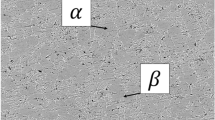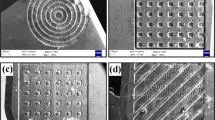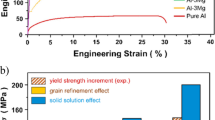Abstract
In machining processes, the friction and frictional stress formation along the interface between the chip and the tool rake face give rise to energy consumption, tool wear, and failure. This study aims to investigate the influence of tool nomenclature (radial rake angle) and cutting conditions (spindle speed and table feed velocity) on the impediment of friction and frictional stress in the perspective of equivalent pressure coefficients during end milling process, and additionally, the comparative study has been made. The experimental outcome clearly indicates that the machining parameter and tool nomenclature have significant effects on frictional stress impediment under pure sliding condition. Among these, tool nomenclature has higher and significant beneficial impact on the obstruction of frictional stress formation, and it is also stated that the cutting force and friction decreases, when the radial rake angle of cutter decreases when the helix angle and the positive axial rake angle is constant.












Similar content being viewed by others
References
Koyee RD, Eisseler R, Schmauder S (2014) Application of Taguchi coupled fuzzy multi attribute decision making (FMADM) for optimizing surface quality in turning austenitic and duplex stainless steels. Measurement 58:375–386
Holmberg K, Matthews A (1994) Coating tribology – properties, techniques and applications in surface engineering. Elsevier Science
Velchev S, Kolev I, Ivanov K, Gechevski S (2014) Empirical models for specific energy consumption and optimization of cutting parameters for minimizing energy consumption during turning. J Clean Prod 80:139–149
Fratila D, Caizar C (2011) Application of Taguchi method to selection of optimal lubrication and cutting conditions in face milling of AlMg3. J Clean Prod 19:640–645
Wang B, Liu Z, Song Q, Wan Y, Shi Z (2016) Proper selection of cutting parameters and cutting tool angle to lower the specific cutting energy during high speed machining of 7050-T7451 aluminum alloy. J Clean Prod 129:292–304
Zheng G, Cheng X, Li L, Xu R, Tian Y (2019) Experimental investigation of cutting force, surface roughness and tool wear in high-speed dry milling of AISI 4340 steel. J Mech Sci Technol 33:341–349
Zhou L, Li F, Zhao F, Li J, Sutherland JW (2019) Characterizing the effect of process variables on energy consumption in end milling. Int J Adv Manuf 101(101):2837–2848
Ozel T, Ulutan D (2014) Effects of machining parameters and tool geometry on serrated chipformation, specific forces and energies in orthogonal cutting of nickel-based super alloy Inconel 100. Proc Inst Mech Eng B 228:673–686
Saglam H, Unsacar F, Yaldiz S (2006) Investigation of the effect of rake angle and approaching angle on main cutting force and tool tip temperature. Int J Mach Tool Manu 46:132–141
Wang B, Liu Z, Yang Q (2013) Investigations of yield stress, fracture toughness and energy distribution in high speed orthogonal cutting. Int J Mach Tool Manu 73:1–8
Gowthaman S, Jagadeesha T (2019) An experimental investigation on the effect of radial rake angle and machining conditions during end milling on wear resistance and residual stress of Nimonic 263 alloy. Mater Res Express 6(12):126568
Gowthaman S, Jagadeesha T (2019) Effect of variation in behavioural changes during end milling on Nimonic 263 elastic constants. Mater Res Express 6(12):126504
Rahman M, Wang ZG, Wong YS (2006) A review on high-speed machining of titanium alloys. JSME Int J Ser C Mech Syst Mach Elem Manuf 49(1):11–20
Nandy AK, Gowrishankar MC, Paul S (2009) Some studies on high pressure cooling in turning of Ti–6Al–4V. Int J Mach Tools Manuf 49(2):182–198
Astakhov VP (2010) Metal cutting theory foundations of near-dry (MQL) machining. Int J Mach Mach Mater 7(1/2):1–16
Weinert K, Inasaki I, Sutherland JW, Wakabayashi T (2004) Dry machining and minimum quantity lubrication. CIRP Ann Manuf Technol 53(2):511–537
Byrne G, Dornfeld D, Denkena B (2003) Advancing cutting technology. CIRP Ann Manuf Technol 52(2):483–507
Altintas Y, Eynian M, Onozuka H (2008) Identification of dynamic cutting force coefficients and chatter stability with process damping. CIRP Ann Manuf Technol 57(1):371–374
Rao BC (2002) Modeling and analysis of high speed machining of aerospace alloys. Purdue University, Doctoral thesis, pp 25–66
Tawakoli T, Hadad MJ, Sadeghi MH (2010) Influence of oil mist parameters on minimum quantity lubrication-MQL grinding process. Int J Mach Tool Manu 50(6):521–531
Sharma VS, Fromentin G, Poulachon G, Brendle R (2014) Investigation of tool geometry effect and penetration strategies on cutting forces during thread milling. Int J Adv Manuf Technol 74(5–8):963–971
Hq L, Shi YC (2006) A comprehensive dynamic end milling simulation model. J Manuf Sci Eng 128(1):86–95
Anand RS, Patra K, Steiner M (2014) Size effects in micro drilling of carbon fiber reinforced plastic composite. Prod Eng Res Dev 8(3):301–307
Sahoo P, Patra K, Singh VK, Gupta MK, Song Q, Mia M, Pimenov DY (278, 2019) Influences of TiAlN coating and limiting angles of flutes on prediction of cutting forces and dynamic stability in micro milling of die steel (P-20). J Mater Process Technol
Sahoo P, Patra K, Szalay T, Dyakonov AA (2020) Determination of minimum uncut chip thickness and size effects in micro-milling of P-20 die steel using surface quality and process signal parameters. Int J Adv Manuf Technol 106:4675–4691
Bartarya G, Choudhury SK (2012) A methodology to estimate the forces on the tool insert in finish hard turning. Int J Mach Mach Mater 11:280–296
Rao S, Shanmugam MS (2012) Analytical modeling of micro end-milling forces with edge radius and material strengthening effects. Mach Sci Technol 16:205–227
Shaw MC (2005) Metal cutting principles. Oxford University Press, N Y, pp 156–158
Wang B, Liu Z, Song Q (2019) An approach for reducing cutting energy consumption with ultra-high speed machining of super alloy Inconel 718. Int J Precis Eng Manuf-Green Technol 7(1):35–51
Liu ZQ, Chen M, Long Q (2015) Investigation of friction in end-milling of Ti-6Al-4V under different green cutting conditions. Int J Adv Manuf Technol 78:1181–1192
Author information
Authors and Affiliations
Corresponding author
Additional information
Publisher’s note
Springer Nature remains neutral with regard to jurisdictional claims in published maps and institutional affiliations.
Rights and permissions
About this article
Cite this article
Gowthaman, S., Jagadeesha, T. Influence of radial rake angle and cutting conditions on friction during end milling of Nimonic 263. Int J Adv Manuf Technol 109, 247–260 (2020). https://doi.org/10.1007/s00170-020-05682-3
Received:
Accepted:
Published:
Issue Date:
DOI: https://doi.org/10.1007/s00170-020-05682-3




